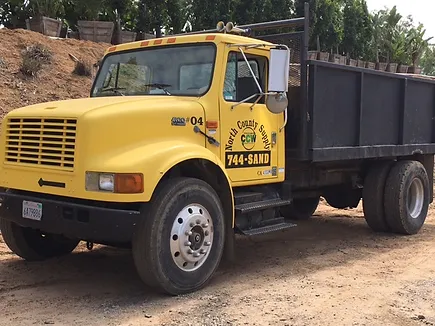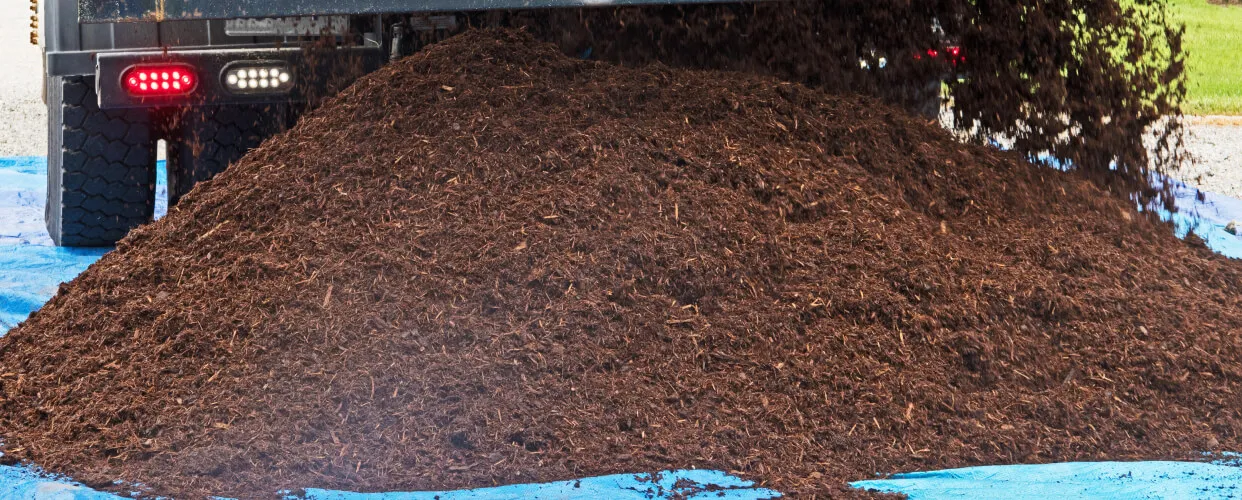When to Replace Mulch in San Diego: Know the Signs
Your mulch is one of the hardest-working elements in your landscape. It shields your soil from San Diego’s scorching sun, helps retain precious water during drought conditions and keeps plant roots cool during summer heat waves. But here’s the reality: mulch doesn’t last forever.
In Southern California’s intense climate, mulch faces serious challenges. Our relentless UV exposure, minimal rainfall and temperature extremes can break down even the best quality mulch faster than in other parts of the country. Add in our Santa Ana winds, and you’ve got conditions that really put mulch to the test.
The good news? Your mulch will tell you when it’s time for a refresh. You just need to know what signs to look for. In this guide, we’ll walk you through the five key signs that indicate it’s time to replace your mulch and show you how easy it is to get fresh mulch delivered throughout the San Diego area.

Sign #1: Your Mulch Has Faded or Lost Its Color
Take a walk around your garden beds and really look at your mulch. If your once-vibrant mulch now looks washed out or gray, that’s your first clear signal that replacement time is approaching.
In San Diego County, color fading happens faster than in many other parts of the country. Our intense UV exposure can turn natural wood mulch from rich brown to pale gray in just six months to a year. Even high-quality dyed mulch, which is specifically treated to resist fading, will eventually lose its color after prolonged exposure.
But here’s why faded mulch is more than just an aesthetic problem: color loss often indicates that the mulch is breaking down and losing its effectiveness. As mulch deteriorates under UV exposure, it also loses its ability to retain moisture, regulate soil temperature and suppress weeds.
Before you rush to replace everything, try this simple test: take a rake and turn over the top layer of mulch. If turning reveals better color underneath, you might extend its life a bit longer. However, if even the lower layers look faded, it’s definitely time for replacement.
According to research from UC Agriculture and Natural Resources, mulch decomposition accelerates in hot, dry climates like ours, with UV exposure being a primary factor.
Sign #2: Weeds Are Breaking Through
If you’re suddenly seeing weeds popping up in areas that were previously weed-free, your mulch isn’t doing its job anymore. Weeds breaking through mulch is probably the most frustrating and obvious sign that replacement is overdue.
Fresh mulch creates an effective barrier that blocks sunlight from reaching weed seeds in the soil below. But as mulch decomposes and thins out over time, those protective qualities disappear. The barrier weakens, light penetrates to the soil and weeds see their opportunity.
As organic mulch breaks down, it actually starts to act more like soil itself. Instead of being a hostile environment for weeds, decomposed mulch becomes a welcoming growing medium where weed seeds can germinate. In Southern California’s climate, where we get winter rains followed by spring growth, this decomposed mulch layer becomes prime real estate for opportunistic weeds.
This is particularly problematic in our water-conscious region. Those weeds aren’t just unsightly – they’re competing with your desirable plants for the limited water you’re providing.
Different mulch types offer varying levels of weed suppression even as they age. Gorilla hair mulch, with its interlocking fibrous strands, tends to maintain its weed-blocking effectiveness longer than other options because it resists thinning and creates a denser mat.
If you’re seeing persistent weed problems despite having mulch in place, that’s a sign the mulch layer has degraded beyond effectiveness, and it’s time for a fresh application.
Sign #3: Your Mulch Is Compacted or Matted
Walk out to your garden beds after you’ve watered or after a rain and watch what happens. Does the water soak in readily, or does it pool on top or run off to the sides? If water isn’t penetrating properly, you’re likely dealing with compacted or matted mulch.
Over time, mulch naturally settles and compacts from the weight of rainfall, regular irrigation and foot traffic. The mulch particles stick together, forming a dense, crusty layer that acts more like a barrier than a protective blanket.
When mulch becomes matted, it creates a frustrating paradox: the very material you applied to help retain moisture is now preventing water from reaching your plants’ roots. This is especially problematic in our semi-arid climate where every bit of irrigation water needs to count.
You can often spot compacted mulch by its texture. Run your hand over the surface – does it feel crusty, hard or stuck together in clumps? Fresh mulch should feel loose and fluffy. Compacted mulch feels more like a solid mat.
Sometimes you can revive slightly compacted mulch by breaking it up with a rake or cultivator. However, if the mulch refuses to fluff up, stays matted even after raking, or quickly compacts again within a few weeks, that’s your sign that the material has broken down too much and needs complete replacement.
Quality bark mulch or shredded mulch with good structure will resist compaction better and maintain proper water flow longer.
Sign #4: You Notice Fungal Growth or Unpleasant Odors
If you’ve spotted white, thread-like growth on your mulch or caught a whiff of something sour or unpleasant when you’re near your garden beds, pay attention. These are warning signs that your mulch has either broken down significantly or has moisture issues that need addressing.
White fungal growth on mulch is actually fairly common and usually harmless to your plants. However, their presence tells you that your mulch is well into the decomposition process and nearing the end of its useful life.
More concerning is when mulch develops a sour, ammonia-like or otherwise unpleasant odor. This smell indicates anaerobic decomposition – meaning the mulch is breaking down without sufficient oxygen. This typically happens when mulch is applied too thickly, becomes waterlogged or gets severely compacted.
In Southern California, there’s another consideration beyond plant health: fire safety. Cal Fire recommends maintaining healthy, well-managed landscape materials as part of creating defensible space around homes.
If you’re dealing with fungal growth on otherwise intact mulch, you might be able to treat it by turning the mulch to increase air circulation. However, if the fungus keeps returning or if you’re detecting foul odors, it’s best to remove the affected mulch completely rather than trying to salvage it.
Sign #5: The Mulch Layer Is Too Thin
Grab a ruler and head out to your landscape beds. If you’re measuring less than 2 inches of mulch depth – or if you can easily see bare soil peeking through – your mulch layer has thinned out beyond effectiveness.
The recommended depth for most mulch applications is 2-4 inches. This is the minimum thickness needed to suppress weeds, retain moisture and regulate soil temperature. When mulch thins below this threshold, it simply can’t do its job properly.
In San Diego County, mulch thinning happens through several mechanisms. Our occasional Santa Ana winds can scatter lighter mulch materials. Winter rains can wash mulch away from slopes or redistribute it unevenly. And natural decomposition steadily reduces the volume as organic materials break down.
Slopes present particular challenges. If you have hillside plantings, you’ve probably noticed mulch tends to migrate downhill over time. This is where gorilla hair mulch really shines – its interlocking fibrous structure resists erosion and stays put even on steep grades.
Here’s a simple way to check your mulch depth: push a ruler or stick down through the mulch until it hits soil, then measure. Do this in several spots throughout each bed because depth can vary significantly. If most areas measure under 2 inches, it’s time to add more mulch.
For playground areas, the depth requirements are even more critical. Certified playground mulch needs to be maintained at 6-12 inches depending on the height of play equipment to provide adequate impact absorption for safety.
Calculating how much replacement mulch you need is straightforward: (Square feet × Depth in inches) ÷ 324 = Cubic yards needed. For example, a 200 square foot bed at 3 inches deep requires about 2 cubic yards.
How Often Should You Replace Mulch in Southern California?
Now that you know the warning signs, you’re probably wondering: how often should I actually be replacing my mulch? For most organic mulches in Southern California, plan on replacement every 1-2 years. This is faster than many other regions because our climate is particularly hard on mulch.
Several factors affect exactly how long your mulch will last. Sun exposure is perhaps the biggest variable – mulch in full sun areas breaks down significantly faster than mulch in shaded spots. The type of mulch you choose makes a big difference too. Bark mulch tends to be more durable and can often make it to the 2-year mark or beyond. Shredded mulch typically breaks down faster – usually within 1-1.5 years.
Timing your mulch replacement right makes a difference. In San Diego County, the best times to refresh your mulch are fall (October-November) and early spring (February-March). Fall application helps protect plants through winter. Early spring application prepares beds for the long, hot summer ahead when moisture retention becomes critical.
According to the San Diego County Water Authority, proper mulching is one of the most effective water conservation strategies for landscapes, potentially reducing irrigation needs by 25-50%. But to get these benefits, your mulch needs to be in good condition.
Rather than waiting until your mulch has failed completely, set a reminder to inspect it twice a year. Spring and fall checkups let you catch problems early and replace mulch before weeds take over or water retention suffers.
Ready to Refresh Your Landscape? We Deliver Throughout San Diego County
Recognizing these five signs – faded color, weed breakthrough, compaction, fungal growth and thinning depth – ensures your mulch is always working as hard as it should to protect your landscape. When you spot any of these warning signals, it’s time to refresh your beds with quality mulch that can stand up to Southern California’s demanding climate.
The good news is that getting fresh mulch doesn’t have to mean countless trips to the garden center. Bulk mulch delivery transforms what could be an exhausting all-day project into a simple, convenient solution. Instead of handling dozens of bags yourself, professional delivery brings exactly what you need right to your property.
North County Mulch offers a complete range of mulch options perfectly suited for San Diego County landscapes. Choose from natural bark mulch for classic durability, gorilla hair mulch for superior slope control, dyed mulch for long-lasting color, shredded mulch for soil enrichment or certified playground mulch for safe play areas.
We proudly serve Escondido, Carlsbad, Oceanside, Poway, Fallbrook, Chula Vista and communities throughout the wider San Diego area. Whether you need a few cubic yards for a small refresh or enough material to completely rejuvenate your entire property, our delivery service makes it easy.
Ready to give your landscape the fresh mulch it deserves? Browse our complete mulch selection online and place your order in minutes, or call us at (760) 871-4535 to speak with our knowledgeable team. We’ll help you choose the best mulch type for your specific needs, calculate exactly how much you’ll need and schedule convenient delivery to your home.
Free delivery quotes are available for all areas we serve throughout San Diego County. Don’t let deteriorating mulch compromise your landscape’s health and beauty. Let North County Mulch handle the heavy lifting so you can focus on enjoying your beautiful, well-protected yard.

